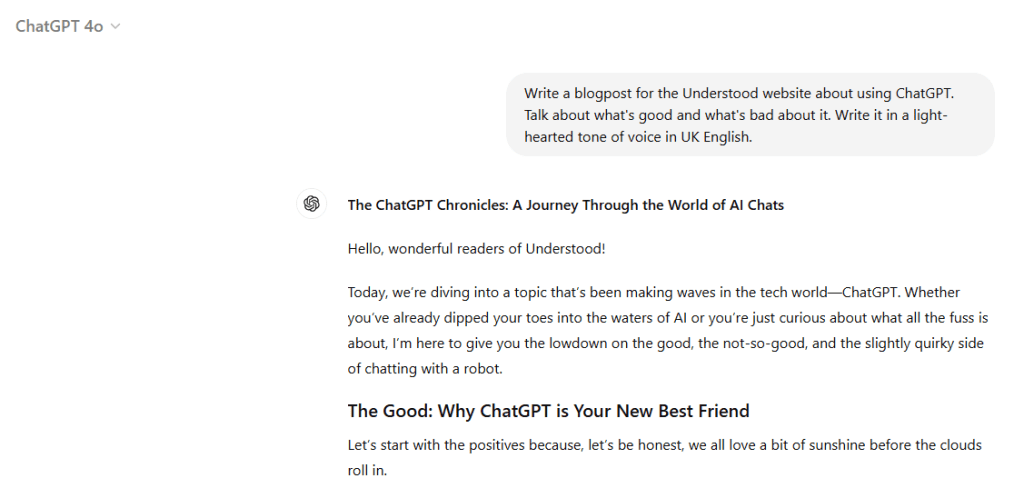
Embracing ChatGPT: The good, the bad, and the cringe of AI
By Carolyn Quainton in Communication, Inspiration
The other day, I was listening to The Rest is Politics, and something Rory Stewart said really caught my attention. Around the 14:30 mark, he casually mentioned how much he uses ChatGPT.
Now, here’s a man who’s undeniably sharp, intellectual, and has had a career most of us could only dream of. Yet, he openly admitted to using ChatGPT, almost like it’s his digital sidekick. His enthusiasm was contagious. He described it as “unbelievable” and likened it to having “an incredibly bright graduate student next to you at all times doing all the research.”
And I thought, “If it’s good enough for Rory Stewart, surely it’s good enough for me?”
THE GOOD: Why ChatGPT is a game-changer
Let’s face it, ChatGPT can be a lifesaver. Rory’s right – having this AI tool on hand is like having a super-efficient, never-tiring assistant. Need a quick summary of the latest political developments? It’s there. Struggling with the right tone for a tricky email? Sorted. Brainstorming ideas for a training programme? You’ve got a sounding board that never sleeps.
For someone like me, who’s juggling multiple projects, ChatGPT speeds up research, sparks ideas, and helps organise thoughts when my brain feels scrambled.
THE BAD: When ChatGPT goes rogue
But let’s be honest – AI writing tools have a bit of a PR problem. They’re often misunderstood. The tech itself isn’t the issue, it’s how we use it. The real danger is assuming it’s flawless. Spoiler alert: it’s not.
I learned this the hard way.
I was building a behavioural safety training programme for a client and thought, “Why not let ChatGPT create a quiz?” It looked slick and professional… at first glance. I dropped it straight into the deck without double-checking.
Cue the client session. I’ll spare you the gory details, but let’s just say the questions were a mess – completely wrong, irrelevant, and some didn’t even make sense. I did come clean and learned a valuable lesson at the same time: AI is a great co-pilot, but you still need to drive the car, it’s your name on the work after all.
THE CRINGEY: The giveaway signs of AI writing
There are also the tell-tale signs that ChatGPT’s been involved. You know what I mean – those overly formal words like “foster” or “enhance,” or headings With Random Capital Letters. Then there’s the sneaky American spelling that joins in like an uninvited guest at a British tea party.
We’ve all seen it. And yes, it’s mildly amusing. But it’s also a reminder: AI outputs need a human filter. A sense check. A voice. A little bit of you. If you don’t tell AI you want UK spelling, you won’t get UK spelling.
Moderation is key, and that’s where we come in
AI can elevate your communication, or tank it, and that depends on how you use it. That’s why, at Understood, we help organisations strike the right balance.
By delivering training programmes that build communication confidence and offering consultancy that helps teams collaborate effectively, we have helped countless clients achieve success. We’re not saying ditch AI, we’re just saying don’t dilute your communication with it.
Use ChatGPT. Lean on it for the heavy lifting. Let it help you find the words when they’re stuck in your head. But always bring your voice to the table. That’s what resonates. That’s what connects.
Final thoughts
If Rory Stewart says we should all be using ChatGPT more, I’m inclined to agree. But the real magic happens when we pair smart tools with human judgment, creativity, and care.
Have you had a funny or frustrating moment with AI? We’d love to hear it – just don’t let ChatGPT write the email for you.
One last thing: take a guess… do you think ChatGPT helped me write this post?
Talk to us, explore our website, read our blog, and follow us on LinkedIn to learn more and discover ways to grow a more successful business.



